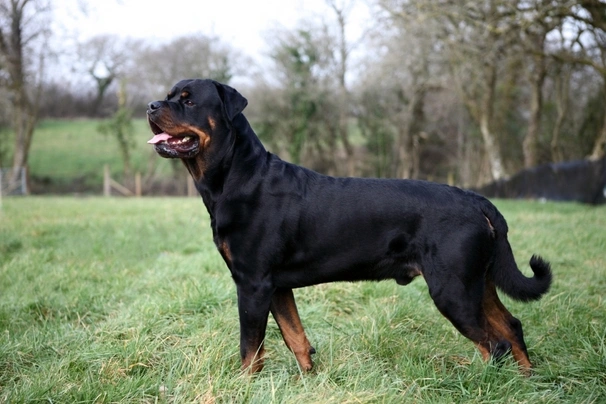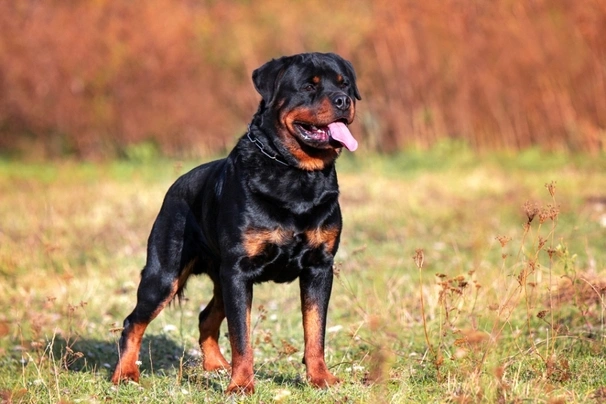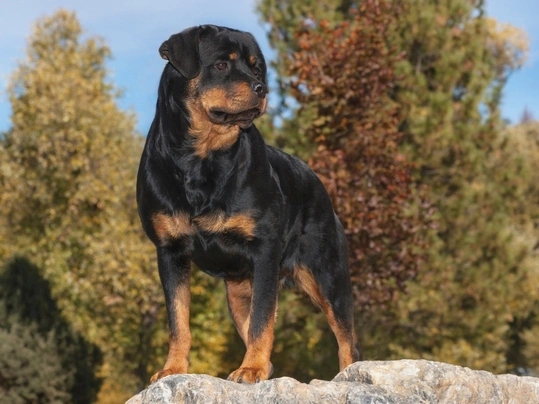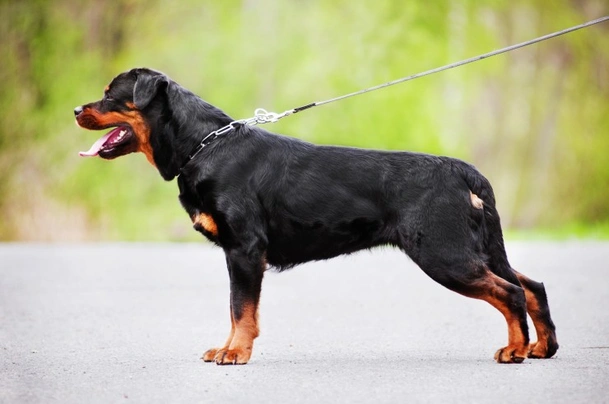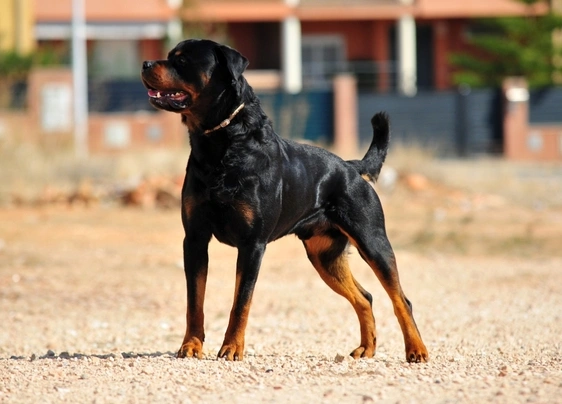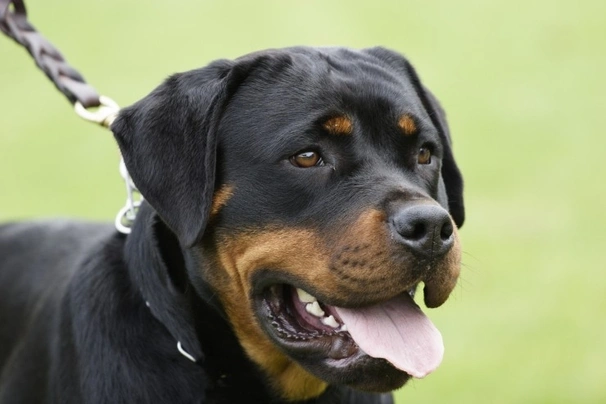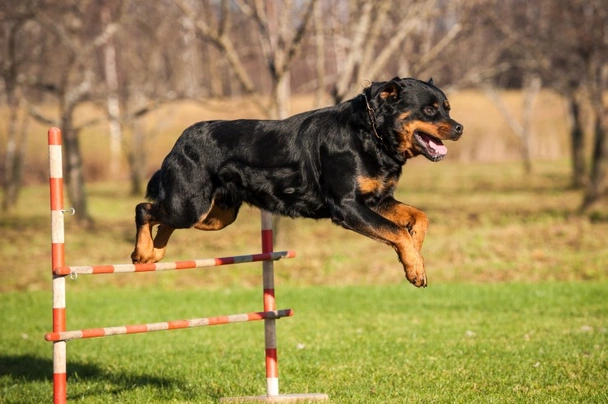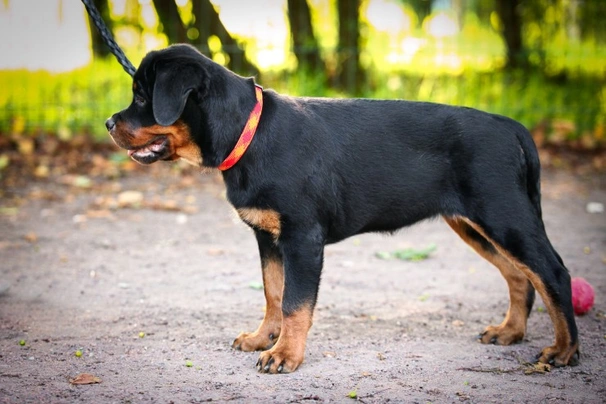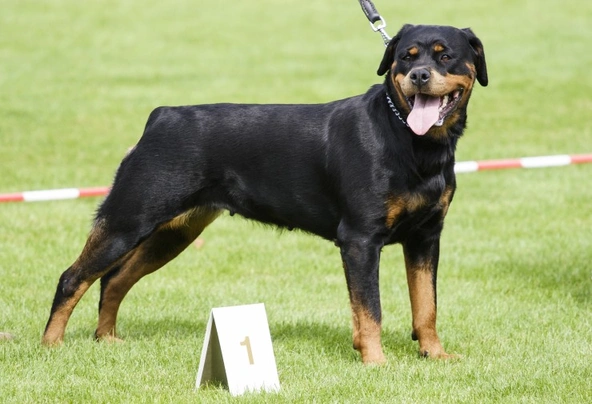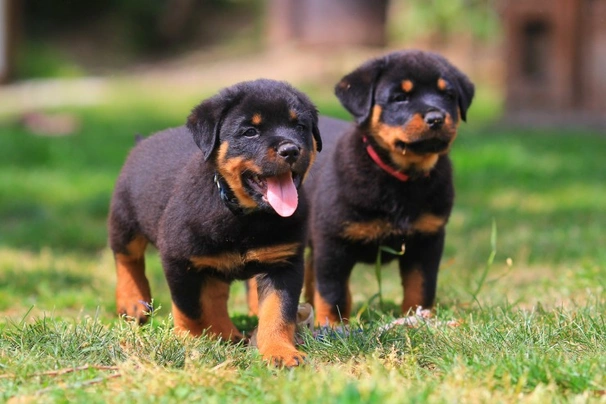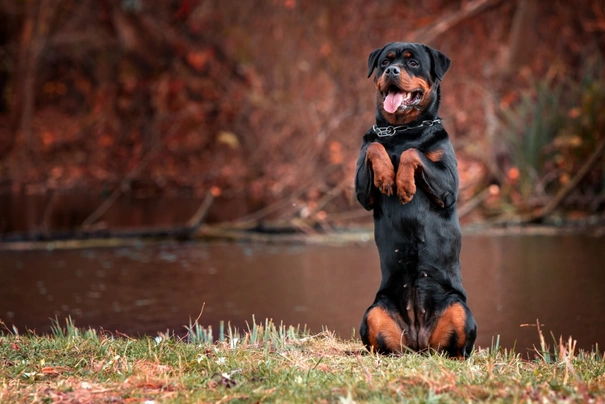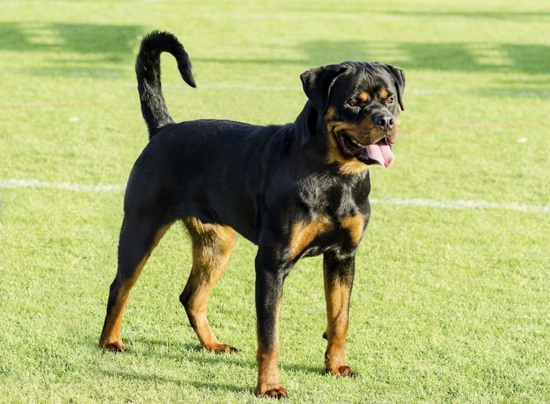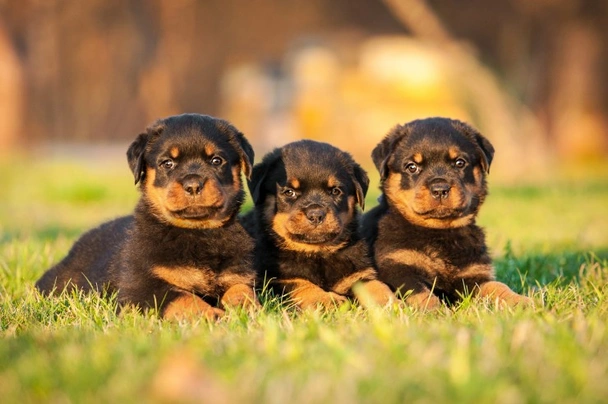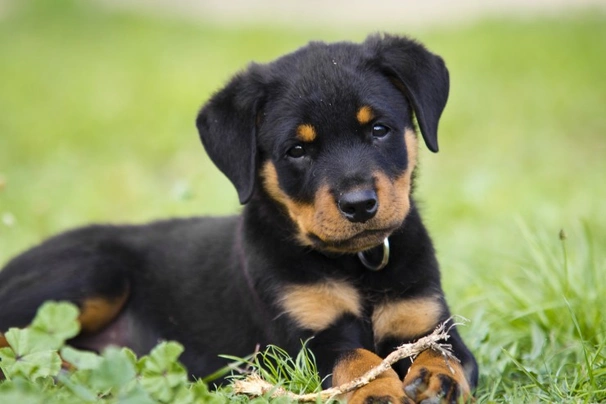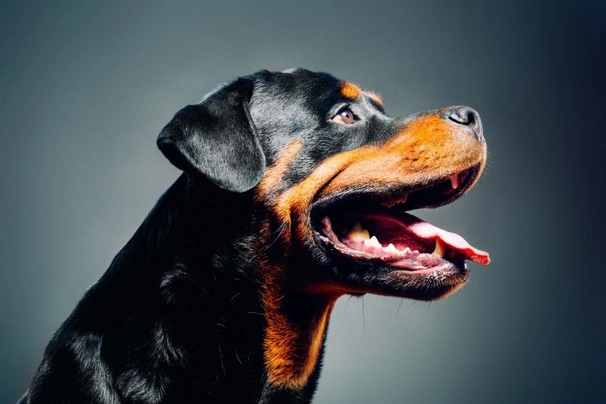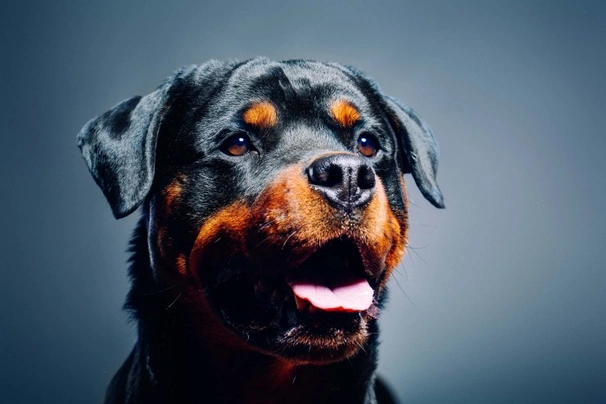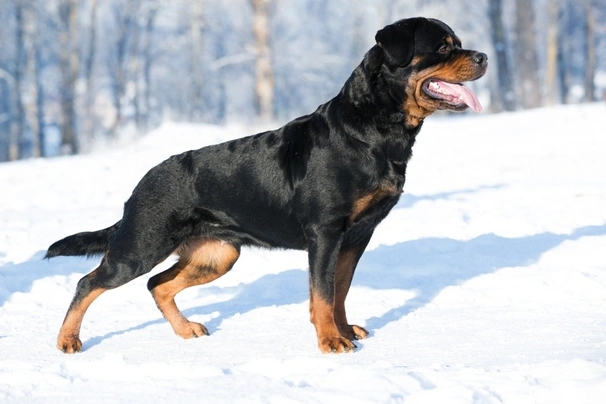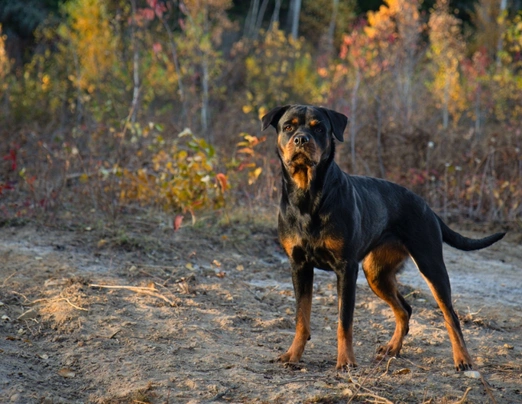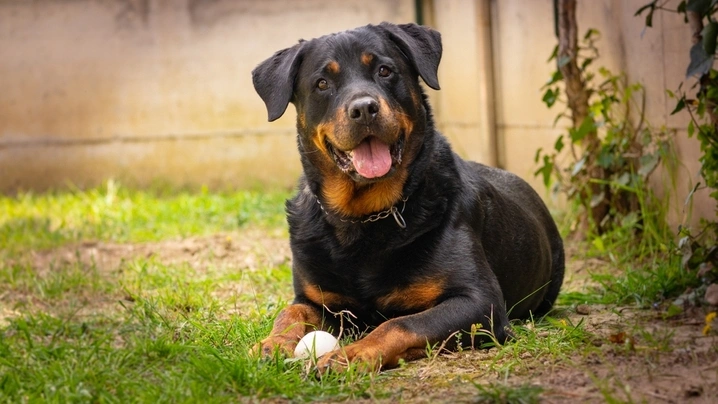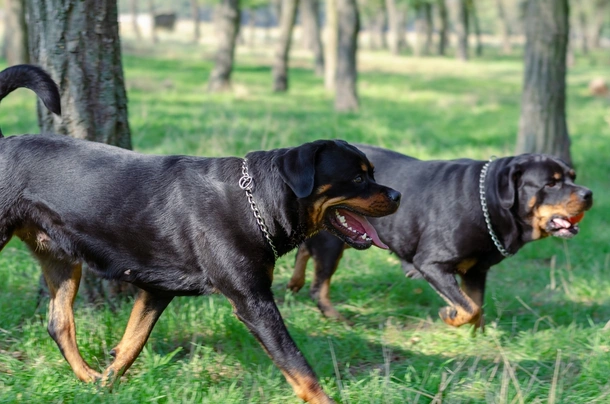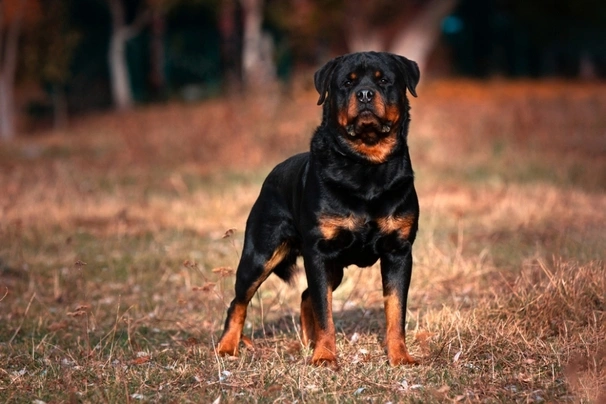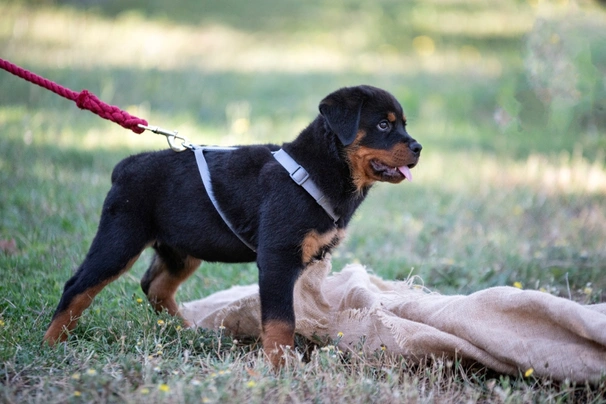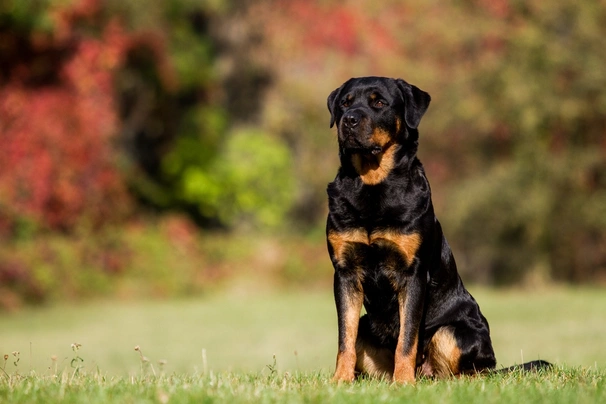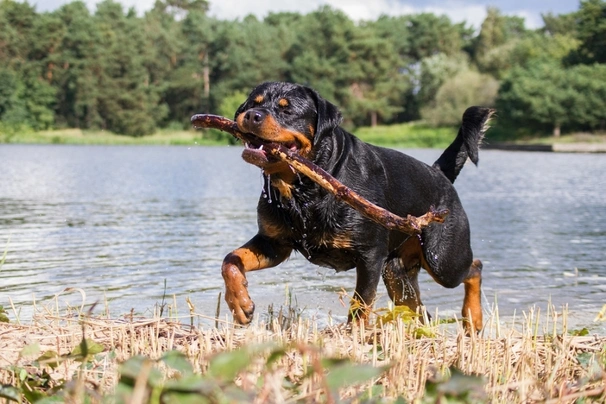Pets
Pets for studWanted petsBreedersAccessories & services
Knowledge hub
Support
Support & safety portalRottweiler
Pros
Cons
Introduction of the Rottweiler
Rottweilers have been a popular choice as family pets and companion dogs for decades both here in the UK and elsewhere in the world. They are powerful and impressive dogs with sleek black and tan coats. Although it’s in a Rottie’s nature to “protect and guard” they are not known to be aggressive by nature although over many years they earned an unfair reputation of being one of the more aggressive breeds in the world. They are extremely loyal which means when needed a Rottweiler will stand their ground with no hesitation at all and protect their owners as well as their property.
They are not the best choice for first time owners even though they are known to be easy to train. The reason being that Rotties must be handled and trained by people who are familiar with the needs of these large intelligent and powerful dogs. They are a great choice for people who have the time and dedication it takes to train them in which case a Rottie becomes a valued member of a family and household. Long ago Rottweilers were described as being the "dark guardians of a family" which describes the breed to a tee.
History of the Rottweiler
The actual origin of the Rottweiler remains a little hazy although it is thought that they have an interesting ancestry. Many people speculate the breed came about when the Romans bought dogs with them during their invasion of Europe which they crossed with native breeds like the Entelbucher the Greater Swiss Mountain Dog as well as some others. all of which are believed to be descendants of these same Roman dogs.
Rotties were often found in southern Germany and Switzerland and the breed was given their name because so many of them were left in the livestock trading town of Rottweil in Germany's southern region of the Black Forest. Their main job back then was to herd and guard livestock and their reputation of being loyal and courageous gradually spreading to other parts of the land.
These large impressive dogs became popular with butchers and were often seen pulling carts. At the time they were known as Rottweiler Metzgerhunds which translated means Rottweil Butcher's Dog and they are thought to be not that different that the Rotties we see today.
By the 19th century Germany had outlawed cattle driving which meant the need for Rotties declined and it was only in 1914 that they again started to be valued for their work as war dogs. In 1882 the first Rottie was shown in Germany with clubs being established quite a few years later in 1907 but by 1910 the Rottweiler had become Germany's official police dog.
Mrs Thelma Gray imported the first Rottweiler to the UK in 1936 but during the next few years right up to 1945 the dogs vanished without having produced any progeny. With this said the Kennel Club recognised the breed in 1936 with a breed standard having been established. At the end of the war a Captain Roy-Smith bought a male and female Rottie over from Germany but had no success in breeding the pair. He then imported another female and managed to breed a litter.
Breed numbers remained quite low with only a handful of enthusiasts working hard to bring the Rottweiler into the limelight in the UK which they successfully achieved by the mid-sixties. Today the Rottie remains a popular choice not only for their guarding abilities but for their impressive yet kind and loyal natures which has seen them find a place in the hearts and homes of many people the world over.
Interesting facts about the breed
- Is the Rottweiler a vulnerable breed? No they are among the most popular dogs in the UK and elsewhere in the world.
- Rotties were once the popular choice with German butchers and were known as the "butcher's dog"
- They would be harnessed to pull carts and drive cattle in times long past
- The Rottweiler is thought to be one of the most ancient breeds having been around at the time of the Romans
- They are descendants of the Molossus a Roman Mastiff-type dog
- Rottweilers were used as Police dogs and excelled at their jobs
Appearance of the Rottweiler
Height at the withers: Males 61 - 69 cm Females 56 - 63 cm
Average weight: Males 50 - 60 kg Females 35 - 48 kg
Rotties are large and impressive dogs being well proportioned powerful and extremely well-muscled. They have broad heads with moderately arched foreheads and nicely muscled cheeks. Dogs have slight wrinkling on their heads when they are alert otherwise the skin is tight. Their muzzles are deep with a well-defined stop. Noses are always black with nice wide large nostrils.
Their eyes are almond shaped and medium in size being dark brown with closely fitting eyelids. Ears are pendant and smallish and set high and wide apart on a dog's head and always lie close to a dog's cheek. Rotties boast a perfect scissor bite where their upper teeth neatly overlap their lower ones. Lips are tight but fall away gradually at each corner of the dog's mouth.
Necks are fairly long and very well-muscled with dogs holding them slightly arched showing a lot of power and strength. Shoulders are well laid back sloping and rather long with Rotties boasting powerful well-muscled front legs. Chests are broad and deep with dog's having well sprung ribs and deep briskets. Backs are level and straight with deep strong flanks. Their croup is broad and slopes very slightly.
Hindquarters are broad and very well-muscled with lower thighs being muscular at the top yet sinewy lower down. Back legs are powerful and very powerful. Their feet are compact round with dogs boasting well-arched toes. Back feet are longer than the front ones. Pads are extremely strong with short dark nails. A Rottie's tail is quite thick adding balance to a dog's overall appearance and is set level to their croup. Dogs carry their tails horizontally but they may hold it slightly higher when excited.
When it comes to their coat the Rottie has a medium length coarse top coat which lies flat to a dog's body. Their undercoat is shorter and grey black or fawn in colour but it does not show through their top coat. The hair on the back of a dog's front legs and breechings is typically slightly longer than on the rest of their body. With this said excessively wavy or long coats are highly undesirable under the Kennel Club breed standard. The accepted coat colours for the Rottweiler is as follows:
- Black & Tan
Black with very well-defined markings which includes a spot over each eye on a dog's cheeks a strip on each side of their muzzle on their throat two triangles on each side of the breast bone on a dog's front legs from carpus down to the toes inside of a dog's back legs that goes from the hock to their toes.
Gait/movement
When a Rottie moves they do so with supple strength and a sense of purpose which gives them the impression of being powerful dogs capable of travelling longer distances. Their backs remain level and firm with a tremendous amount of power coming from a dog's hindquarters. Their movement must be well balanced free moving and positive with dogs showing a tremendous amount of power and balance.
Faults
The Kennel Club frowns on any exaggerations or departures from the breed standard and the seriousness of the fault would be judged on how much it affects a Rottie's overall health and wellbeing as well as their ability to perform.
Male Rottweilers must have both testicles fully descended into their scrotums and it is worth noting that the size of a Rottie can be a little smaller or slight bigger as well as being a little taller or slightly shorter than stated in their Kennel Club breed standard which is to be used only as a guide for the breed.
Temperament of the Rottweiler
The Rottweiler is known to be an active dog and one that needs lots of exercise as well as mental stimulation for them to be truly happy well-balanced characters. As previously mentioned they are not the best choice for first time owners because they need to be handled by someone who has the right sort of experience in handling and training such an intelligent impressive and powerful dog.
It's essential for a Rottweiler's training to start early and puppies must be well socialised from a young age for them to grow up to be more confident relaxed adult dogs. It's vital for these dogs to be treated with a lot of respect and to use positive reinforcement when training them. Rotties are known to be confident and highly intelligent which means they quickly pick up new things but this includes the good and the bad. However in the right hands they are obedient and extremely devoted dogs that excel at all sorts of canine sporting activities.
Although a Rottie does make a good family pet their sheer size means taking care when they are around younger children. They are a very good choice for people who work from home or for families where one person usually stays at home when everyone else is out of the house because they do not like being left on their own for long periods of time which can lead to a Rottie developing a condition known as separation anxiety.
A fully mature Rottweiler is an extremely strong dog and one that can be very demanding as well as arrogant at times. The instinct to "guard" is a trait that is deeply embedded in their psyche which must be well understood when sharing a home with a Rottie. People unfamiliar with the personality of a Rottweiler often do not understand that these dogs do not need to be taught to "guard and protect" the reason being it’s a Rotties natural instinct to do so.
With this said the Rottweiler thrives in a home environment and as previously touched upon they hate being left on their own for any length of time. A Rottie is never happier than when they can be with their owners and will follow them around just to be with them and to check out what's going on in their environment and hate it when they are left out of anything.
It is vital that breeders only breed from Rottweilers with sound temperaments and who spend a lot of time and effort socialising their puppies right from the word go. As such stud dogs must be "temperament assessed" which tests how a Rottie reacts and behaves in a lot of different situations and settings they are bound to encounter during their life time. The assessment should include the following:
- What is the impression a Rottie gives off? It should be of a dog that is reserved friendly confident relaxed and calm
- How does a Rottie react to someone who approaches in a friendly manner? A Rottweiler with a sound temperament would show no aggression or fear towards anyone who approaches them or their owners providing they do so in a friendly way
- How does a Rottie react to a more unusual approach which could include someone in a wheelchair or on crutches? A dog with a sound temperament would not react at all nor would they feel threatened in any way
- How does a Rottweiler react to loud noises? A confident dog with a good temperament would not react in an adverse way at all to loud and sudden sounds like a car back-firing being one example
- How does a Rottie react to other dogs? A well balanced even tempered Rottweiler would take things in their stride no matter what other dog they meet providing the dog does not approach them in an aggressive way
Providing a young Rottweiler is not left with a "bad experience" during the first few months of their lives they generally mature into confident relaxed dogs that take things in their stride. It is recommended that all breeders have their stud dogs "temperament assessed" before using them for breeding purposes and potential owners should ask the breeders about this before buying a puppy from them.
Are they a good choice for first time owners?
Rottweilers are a demanding breed and therefore as previously touched upon they are better suited to people who are familiar with their needs and who has enough time to dedicate to training their dogs. Puppies must be well socialised and taught ground rules from a young age so they understand right from the word go who is alpha dog in a household and who they can look to for direction and guidance before they grow into impressive and imposing large mature dogs. As such they are not a good choice for first time dog owners.
What about prey drive?
The Rottweiler has a high prey drive but with the right amount of early socialisation and training handlers and owners can control their dogs whenever they meet another animal with the emphasis being on the need for Rotties to be well handled socialised and trained when still young and therefore most receptive and easier to handle.
What about playfulness?
Rotties mature slowly and therefore remain extremely playful right up to when they are anything from 2 to 3 years old and beyond. They enjoy playing all sorts of interactive games which includes activities like “fetch” or find the treat when one has been hidden for them.
What about adaptability?
Because of their sheer size and weight Rottweilers are better suited to living in a house with a back garden where they can express themselves as they should. With this said garden fencing must be ultra-secure to keep a Rottweiler safely in.
What about excessive barking?
Rottweilers are not given to barking excessively for no reason. They do however let an owner know when there are strangers about or when they don't like something that may be happening in their environment because they are extremely good watchdogs. With this said any dog that’s left on their own for long periods of time may bark incessantly to get some attention and as a way of showing how unhappy they are.
Do Rottweilers like water?
Some Rotties love swimming whereas others don't like the idea of getting their feet wet and it would be a mistake to force a dog to do jump in water if they look frightened. On the other hand anyone who shares a home with a Rottie that loves water should take great care when walking their canine companions anywhere near more dangerous watercourses just in case they leap in.
Are Rottweilers good watchdogs?
The Rottweiler is a "natural" watchdog because guarding and protecting is a trait that is deeply embedded in their psyche. As such they are among the best watchdogs around and don’t need to be taught to guard anything when it comes to protecting anything.
Intelligence / Trainability of the Rottweiler
The Rottweiler is one of the most intelligent dogs on the planet and therefore they learn new things extremely quickly. The downside to this is that a Rottie would be just as quick to pick up some bad habits as they are the good. They need to be handled with a firm yet sympathetic approach that is always consistent right from the word go and throughout their lives which is one of the reasons they are better suited to people who are familiar with their needs.
Rottweilers need to be well socialised when they are puppies and it cannot be stressed strongly enough that their training must start as early as possible too. Failure to socialise a puppy or train a young dog correctly is a recipe for disaster both for a Rottie and their owners. They are extremely intelligent but they also boast a very dominant side to their characters. As such they need to be taught their place in the pack and who is alpha dog in a household for them to be truly well-rounded dogs.
They are among the breeds that are super sensitive to a person’s voice and as such respond well and extremely quickly when they are given a command. With this in mind it is worth noting that great care has to be taken when training a Rottweiler to avoid getting them too excited which could result in a dog becoming unruly and unmanageable.
The first commands a Rottweiler puppy should be taught as soon as they arrive in their new homes are as follows:
- Come
- Sit
- Stay
- Quiet
- Leave it
- Down
- Bed
Mature Rotties excel at many canine sports and in the right hands and environment they are easy to train to take part in the following activities which they thoroughly enjoy:
- Competitive obedience - an activity that requires a tremendous amount of precision and accuracy which includes dogs doing heelwork recall retriever send away stays scent distance control
- Agility - a fun activity that Rottweilers are known to enjoy which sees dogs having to negotiated obstacles which includes things like jumps weaving poles A-frames dog walk seesaw tunnels and tyres
- Flyball - a team activity where 4 dogs compete in relay jumping hurdles and catching a flying ball when they step on a pedal that releases it into the air before chasing back to their handlers over the same set of jumps
- Working trials/IPO - for the more serious competitors take part in working trials that consist of four disciplines which are control agility tracking and protection
Children and other
As previously mentioned Rotties need to be treated with a great amount of respect but when they bond with a family the bond remains very strong throughout their lives. In short a Rottweiler becomes totally devoted to their owners and families. If they are given the right amount of daily exercise and enough mental stimulation they are good pets but care has to be taken when they are around children especially toddlers who may not yet have been taught how to behave around dogs. As such Pets4homes advises that Rotties are not the best choice for families with babies or very young children.
Anyone who already shares a home with a Rottie and younger children should always make sure they are never left together unattended. It is also crucial for parents to teach young children how to behave around dogs and when to stay away from them particularly when there is food around or during playtime.
Care also has to be taken when Rotties are around cats and other smaller animals which includes family pets. It would be a mistake to leave a Rottie in the same room with them. If they have been well socialised as puppies and trained by someone who really appreciates the strong herding and guarding instincts of the Rottweiler they will tolerate other dogs but care must be taken when they are around any dogs they don't already know because a Rottie could show a more aggressive side to their natures when they first meet a new dog.
Health of the Rottweiler
The average life expectancy of a Rottweiler is between 8 and 10 years when properly cared for and fed an appropriate good quality diet to suit their ages.
It's essential that breeders only use "temperament-tested" dogs in their breeding programmes which helps ensure their offspring inherit their kind natures. It's worth noting that like so many other breeds the Rottweiler is known to suffer from a few hereditary health issues with the conditions that seem to affect them the most being as follows:
- Cancer
- Eye problems - Tests available
- Entropion (Eyelids Folding Inwards) - an inherited disorder in the breed
- Ectropion - an inherited disorder in the breed
- Cruciate Ligament Rupture
- OCD (Osteochondritis Dessicans)
- Wet Eczema
- Cold Water Tail
- Hip Dysplasia - Stud dogs must be hip scored
- Elbow dysplasia - Stud dogs must be tested
- Bloat
- Prone to obesity
- Aortic stenosis
- Temperament issues
More about Aortic Stenosis
Aortic stenosis is a very serious condition that is known to affect Rotties with some puppies suffering from "innocent" heart murmurs which in time vanish whereas in other dogs their condition needs a lot more in the way of investigation to determine how much their hearts have been affected. Any dog known to suffer from aortic stenosis should never be used for breeding purposes because they may well pass the disorder onto their offspring.
Reputable breeders would have their stud dogs heart tested through the BVA scheme and would have a certificate showing they are clear of the condition with the results showing a "Normal" reading. More about the condition can be found here.
More about Entropion
Entropion is a painful eye disorder where a dog's eyelids roll inwards causing a tremendous amount of irritation to the fragile surface of the eye. Once a cornea is damaged it can lead to ulcers forming. There are different degrees as to how bad the condition might be with more severe cases needing surgical intervention. It is an inherited condition and as such no Rottweiler known to suffer from the disorder should be used for breeding purposes.
More about Ectropion
Ectropion sees a dog's eyelids rolling outwards with most dogs getting better as they mature. However the disorder does put dogs most at risk of developing conjunctivitis although any invasive sort of surgery is not generally needed. Ectropion is an inherited condition and as such no Rottweiler known to suffer from the disorder should be used for breeding purposes.
More about Cruciate Ligament Rupture
The cruciate ligaments are found behind a dog's kneecap and they cross over which holds both the lower and upper parts of a dog's back legs in place. If they rupture or stretch it is not only extremely painful but it can prevent a dog from walking properly more especially if a ligament snaps. The good news is that the problem can be resolved through surgery. The bad news is the condition is thought to be partly hereditary and therefore any dog that was diagnosed as having the condition should not be used in a breeding programme. With this said a dog can also rupture their cruciate ligaments in a number of other ways too which includes through injury.
More about OCD (Osteochondritis Dessicans)
OCD generally affects a dog's joints namely their shoulders elbows and hocks. It is often seen in Rotties when they are anything from 4 to 6 months old. The problem occurs when both bone ends in a joint don’t develop at the same time or when they are misshapen for any reason. The result is that the bone ends are not covered in much needed synovial fluid which then leads to them grating against each other. Tiny bits of bone are dislodged and float in a dog's joints causing pain and even ulceration. The problem can be corrected through surgical intervention although the procedure often proves unsuccessful.
More about Wet Eczema
Unfortunately many Rottweilers suffer from a condition known as Wet Eczema because of their thick undercoats. A mere flea bite can cause a flare up and the condition can quickly turn very nasty if not treated as early as possible spreading quickly. As such any Rottie with the condition needs to see a vet and be given the right sort of treatment sooner rather than later.
More about Cold Water Tail
Rottweilers also suffer from a condition that affects many working dogs which is known as "Cold-water Tail". Unfortunately not much is known about the condition but the signs of there being something wrong include when a dog's tail goes "dead" at the base when they are either sitting near cold water or snow. Their tail hangs limply from around 4 or 5 inches from the base and can remain like that for anything from 2 to 5 days. Some owners place a warm towel or compress at the base of their dog's tail as a way of warming them up more quickly to resolve the problem.
More about tail docking in Rottweilers
Before the law banning tail docking came into effect in 2007 Rotties traditionally had their tails docked but since the Animal Welfare Bill was made law it is now illegal to do so. Many people believe that the fact a Rottie can wag their tail conveys a lot of how they may be feeling about something and as such it gives a better impression not only to other dogs they encounter but to people too.
What about vaccinations?
Rottweiler puppies would have had their first vaccinations but it's essential for them to have their follow-up jabs at the right time with the vaccination schedule being as follows:
10 -12 weeks old bearing in mind that a puppy would not have full protection straight away but would be fully protected 2 weeks after they have had their second vaccination
There has been a lot of discussion about the need for dogs to have boosters. As such it's best to talk to a vet before making a final decision on whether a Rottweiler should continue to have annual vaccinations which are known as boosters.
What about spaying and neutering?
A male Rottweiler can safely be neutered when they are 6 months old and females can be spayed when they are 6 months old too.
What about obesity problems?
Some Rotties gain weight after they have been neutered or spayed and it's important to keep a close eye on their calorie intake and the amount of daily exercise they get to prevent obesity. An obese Rottie would be put at risk of developing certain health issues which could end up shortening their lives by several years.
What about allergies?
As previously mentioned Rotties are prone to developing a condition known as Wet Ezema which if left untreated can prove notoriously hard to clear up. With this said some Rotties are also prone to suffering from allergies which can be triggered by several things which includes the following:
- Environment
- A reaction to certain chemicals commonly found in household cleaning products
- Seasonal allergies which includes pollen and grasses
- Food which includes certain meats and cereals often used as ingredients in commercially produced dog food
- Tick flea and other parasite bites
- Dust mites
- Mould
Participating in health schemes
It is mandatory for all Kennel Club Assured Breeders to have stud dogs tested for hip dysplasia as well as elbow dysplasia using the following schemes and the KC highly recommends that other people who would like to breed Rotties do the same:
The Kennel Club also highly recommends that all breeders including Assure Breeders should have stud dogs tested using the following schemes:
Other advice and recommendations offered by the Kennel Club include the following:
- A Rottweiler bitch should produce a litter when she is under the age of two years old
- Bitches must not have more than one litter in any 12-month period
- A Rottweiler bitch should not have more than 4 litters in her lifetime
Other schemes available for Rottweilers which the Kennel Club advises should be used for breeding stock includes the following:
- Juvenile Laryngeal Paralysis & Polyneuropathy (JLPP) - DNA test
What about breed specific breeding restrictions?
Currently there are no breed specific breeding restrictions for the Rottweiler in place under the Kennel Club rules.
What about Assured Breeder requirements?
It is mandatory for all Kennel Club Assured Breeders to have breeding stock tested using the following schemes:
The Kennel Club also highly recommends that all breeders have their breeding stock tested using the following schemes:
- Eye testing
Caring for the Rottweiler
As with any other breed Rotties need to be groomed on a regular basis to make sure their coats and skin are kept in top condition and to make sure a dog is not suffering from Wet Eczema which if left untreated can quickly develop and spread into a nasty infection. They also need to be given regular daily exercise to ensure they remain fit and healthy. On top of this dogs need to be fed good quality food that meets all their nutritional needs throughout their lives.
Caring for a Rottweiler puppy
Rottie puppies take a long time to mature and they are expensive to keep during the first 12 months of their lives. All reputable Rottweiler breeders would ask potential owners very specific questions to make sure they are able to look after this type of dog because as with any other breed deciding to share a home with a Rottweiler takes a lot of thought and consideration because it is a long-term commitment and Rotties are expensive to own bearing in mind vet fees can be high and that Rottweilers are quite demanding too.
No Rottie puppy should be sold until they are 8 weeks old. Puppies should have been wormed and had their first vaccination. They must also have all the correct paperwork which includes Kennel Club registration and microchip details. Parent dogs should both have been hip and elbow scored and some breeders also carry out other tests which includes on their stud dog’s hearts and eyes.
A puppy's training must start as soon as they arrive in their new homes which should include house training as well as getting them used to wearing a collar and walking albeit tentatively on a lead. The timing of when a puppy is introduced to their new environment is crucial because it would be a mistake to leave them on their own during the first week of their arrival. As previously mentioned Rotties are extremely intelligent and they are quick to learn things they are shown and taught which includes when they are still puppies. As such it's essential they be well socialised as soon as possible and this means introducing a Rottie puppy to as many new situations people dogs and other animals so they mature into relaxed and calm dogs to be around.
A lot of owners take their puppies along to training clubs which is a great way of socialising a young Rottie in a safe environment that's typically well supervised. The rewards of spending enough time with a Rottie when they are young heaps lots of rewards with the end result being a happy loyal and devoted canine companion that is not intimidating at all.
Puppies need to nap a lot during the day so it's important to set up a quiet area for them to do so although it should not be too out of the way. A puppy needs to know there is someone around and that they are not on their own and it's important to be able to keep a watchful eye on them from a distance just in case they get into trouble and need rescuing.
It's also important to puppy-proof a home and garden which ideally needs to be done well in advance of their arrival. All puppies dog like to gnaw on things and this includes electric cables so making sure they are out of a puppy's reach is essential. Any garden tools and other implements also need to be put away to avoid a puppy from injuring themselves when they are romping around in a garden bearing in mind that Rottie puppies can be very boisterous at times.
A Rottie puppy would have been wormed before being sold and as previously mentioned the documentation a breeder provides must have all the details of their worming date and the product used as well as the information relating to their microchip. It is essential for puppies to be wormed again keeping to a schedule which is as follows:
- Puppies should be wormed at 6 months old
- They need to be wormed again when they are 8 months old
- Puppies should be wormed when they are 10 months old
- They need to be wormed when they are 12 months old
Things you'll need for your puppy
There are items needed to care for a puppy which should be purchased well in advance of their arrival. The items needed include the following:
- Feed and water bowls making sure they are not too deep and ideally they should be ceramic rather than plastic or metal
- A good quality dog collar harness and lead
- A dog crate that's not too small or too big that a puppy would feel lost in it
- A well-made dog bed bearing in mind that a puppy could well chew on it
- Baby and/or dog blankets to use in the puppy's crate and dog bed
- Dog specific toothpaste and tooth brush
- Shampoo and conditioner specifically formulated for use on dogs
- Grooming equipment
Keeping the noise down
All puppies are very sensitive to loud noises so it is important to keep the volume of a television down and not to play music too loudly either because it could frighten a Rottweiler puppy and prevent them from napping as they should during the day.
Keeping vet appointments
Reputable breeders would always ensure their puppies vaccinated before they are sold but as previously mentioned it is up to their new owners to make sure they are given their follow-up shots at the right time which should be as follows:
- 10 -12 weeks old bearing in mind that a puppy would not have full protection straight away but would only be fully protected 2 weeks after they have had their second vaccination
When it comes to boosters it's best to discuss these with a vet because there is a lot of debate about whether a dog really needs them after a certain time. However if a dog ever needed to go into kennels their vaccinations would need to be
What about Rottweilers when they reach their golden years?
When Rottweilers reach their golden years they do slow down in many ways and they might start showing their age with more grey hairs appearing on their faces and more especially around their muzzles. Apart from a change in their appearance a Rottweiler's personality might change too and this includes on how quick they are to respond to a command or when their names are called. The reason for this is that many older dog's hearing is not as good as it once was. Other changes to watch out for in a Rottweiler when they reach their senior years include the following:
- Their vision might be impaired and their eyes seem cloudy
- Their teeth might not be as in good condition which means they may need dental work
- Older dogs tend to sleep more during the day and they get up more frequently at night which is often because their cognitive function is not as sharp as it was when they were young which means older dogs are more easily confused
- They tend to be less tolerant of loud noises and sounds
- Dogs when they are older can be a little fussier about their food so it's important to rethink their diet and to make sure they are getting all the nutrients they need to stay healthy
- An older dog's immune system often does not offer them the same protection against illness and infection which puts them more at risk of catching something and why they should see the vet more routinely
- An older Rottweilers might not be so keen to go out for a walk and more especially longer ones
- They muscle tone and body condition is not as good as when they were young
- Because of their size Rottweilers often suffer from joint problems which can then lead to arthritis so it's well worth investing in a comfy dog bed and ideally one that a Rottweiler finds easier to get out of
Grooming of the Rottweiler
A Rottie's coat is short and it's a thick double coat that is low maintenance when it comes to keeping it in tidy and in good condition. A weekly brush and rub with a chamois leather is all it takes to keep on top of things. Like other breeds the Rottweiler sheds more during the spring time and then again in the autumn when more frequent brushing would be necessary to get rid of any dead hair and to prevent dogs from leaving it all over the house.
It's also important to check a Rottie's ears on a regular basis and to gently clean them when necessary. If there is a build of wax in a dog's ears it provides the perfect environment for an infection to take hold and these are known to be hard to clear up. In short prevention is much easier than cure.
Grooming tools needed for a Rottweiler
Having the right grooming tools helps keep a Rottweiler's coat and skin in top condition. The tools needed to keep a dog's coat looking good are as follows:
- A grooming glove
- A slicker brush
- A bristle brush
- A fine toothed comb
- Nail clippers
- A pair of round ended scissors
- Dog specific shampoo and conditioner
Exercise of the Rottweiler
Rotties are intelligent high energy dogs and as such they need to be given lots of daily exercise and heaps of mental stimulation for them to be truly happy well-rounded characters. They also need lots of space to move around being such large dogs. A minimum of 2 hours exercise a day is essential with as much time romping around in a secure back garden as possible.
A well trained Rottie can be let off the lead in a safe environment whether it's in a park or in the countryside because they never tend to stray too far away from their owners thanks to their total devotion to them. Some Rotties also love swimming so care must be taken when walking near rivers ponds or other watery environments just in case a dog decides to jump in.
With this said young Rottie puppies should not be given too much exercise because their joints and bones are still growing and too much pressure on them could result in causing a dog a few problems later in their lives.
Feeding of the Rottweiler
If you get a Rottie puppy from a breeder they would give you a feeding schedule and it's important to stick to the same routine feeding the same puppy food to avoid any tummy upsets. You can change a puppy's diet but this needs to be done very gradually always making sure they don't develop any digestive upsets and if they do it's best to put them back on their original diet and to discuss things with the vet before attempting to change it again.
Older dogs are not known to be fussy or finicky eaters but this does not mean you can feed them a lower quality diet. It's best to feed a mature Rottweiler twice a day once in the morning and then again in the evening making sure it's good quality food that meets all their nutritional requirements. It's also important that dogs be given the right amount of exercise so they burn off any excess calories or they might gain too much weight which can lead to all sorts of health issues. Obesity can shorten a dog's life by several years so it's important to keep an eye on their waistline from the word go.
Because Rotties are prone to suffer from bloat it is very important that they be fed twice a day instead of giving them just one larger meal a day. It's also a good idea to invest in a stand to place their feed bowl which makes it easier for these large dogs to eat comfortably without having to stretch their necks down low to reach their food. You should never feed a dog just before or just after they have eaten either because this puts them more a risk of suffering from bloat.
Feeding guide for a Rottweiler puppy
Once a puppy is settled into their new homes it is safe to change their diets but as previously touched upon it needs to be done gradually and carefully to avoid any tummy upsets. As a rough guide Rottweiler puppies can be fed the following amounts every day to ensure they are getting all the nutrients they need to grow and develop properly:
- 2 months old - 309g to 527g depending on a puppy's build
- 3 months old - 406g to 710g depending on a puppy's build
- 4 months old - 449g to 789g depending on a puppy's build
- 5 months old - 534g to 952g depending on a puppy's build
- 6 months old - 607g to 1084g depending on a puppy's build
- 7 months old - 609g to 1104g depending on a puppy's build
- 8 months old - 605g to 1025g depending on a puppy's build
- 9 months old - 557g to 1093g depending on a puppy's build
- 10 months old - 521g to 1048g depending on a puppy's build
- 11 months old - 476g to 991g depending on a puppy's build
- 12 months old - 434g to 941g depending on a puppy's build
- 13 months old - 431 g to 884g depending on a puppy's build
- 14 months old - 426g to 831g depending on a puppy's build
Feeding guide for a Rottweiler
As a rough guide an adult fully grown Rottweiler can be fed the following amounts every day to ensure they stay fit and healthy:
- Dogs weighing 35 kg can be fed 360g to 552g depending on activity
- Dogs weighing 50 kg can be fed 447g to 682g depending on activity
- Dogs weighing 60 kg can be fed 500g to 762g depending on activity
Rottweiler price
If you are looking to buy a Rottweiler you would need to pay anything from £350 to over £1000 for a well-bred pedigree puppy. The cost of insuring a male 3-year-old Rottie in northern England would be £60.70a month for basic cover but for a lifetime policy this would set you back £130 a month (quote as of August 2017). When insurance companies calculate a pet's premium they factor in several things which includes where you live in the UK and a dog's age and whether they have been neutered or spayed.
When it comes to food costs you need to buy the best quality food whether wet or dry to feed your dog throughout their lives making sure it suits the different stages of their lives. This would set you back between £60 - £70 a month. On top of this you would need to factor in veterinary costs if you want to share your home with a Rottweiler and this includes their initial vaccinations their annual boosters the cost of neutering or spaying your dog when the time is right and their yearly health checks all of which quickly adds up to over a £1000 a year.
As a rough guide the average cost to keep and care for a Rottweiler would be between £120 to £160 a month depending on the level of insurance cover you opt to buy for your dog but this does not include the initial cost of buying a well-bred pedigree puppy.
Buying advice
When visiting and buying any puppy or dog there are many important things to consider and questions to ask of the breeder/seller. You can read our generic puppy/dog advice here which includes making sure you see the puppy with its mother and to verify that the dog has been wormed and microchipped.
The Rottweiler is an extremely popular breed both in the UK and elsewhere in the world which means that well-bred puppies command a lot of money. As such with the Rottweiler there is specific advice questions and protocols to follow when buying a puppy which are as follows:
- Beware of online scams and how to avoid them. You may see online and other adverts by scammers showing images of beautiful Rottweiler puppies for sale at very low prices. However the sellers ask buyers for money up front before agreeing to deliver a puppy to a new home. Potential buyers should never buy a puppy unseen and should never pay a deposit or any other money online to a seller. You should always visit the pet at the sellers home to confirm they are genuine and make a note of their address.
- As previously touched upon the Rottweiler is among the most popular breeds in the UK. As such there are many amateur breeders/people who breed from a Rottweiler far too often so they can make a quick profit without caring for the welfare of the puppies their dam or the breed in general. Under Kennel Club rules a dam can only produce 4 litters and she must be between a certain age to do so. Anyone wishing to buy a Rottweiler puppy should think very carefully about who they purchase their puppy from and should always ask to see the relevant paperwork pertaining to a puppy's lineage their vaccinations and their microchipping
- Before the tail docking law came into effect in 2007 Rotties traditionally had their tails docked but since the Animal Welfare Bill came into effect it is now illegal to do so and anyone who does dock a Rottie puppy's tail would be subject to a heavy fine
Related adverts
See all
Rottweiler puppies for sale
£1,150

Rotweiller pups for sale
£1,350
Rottweiler puppies
£950
